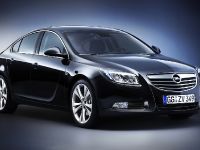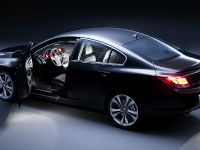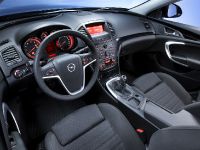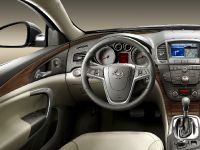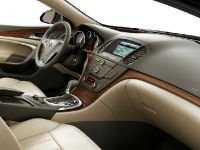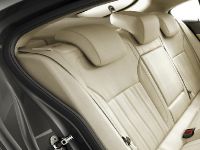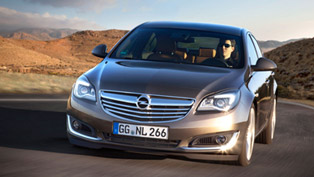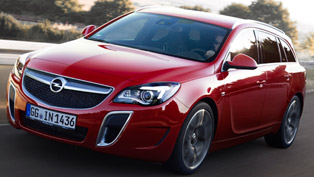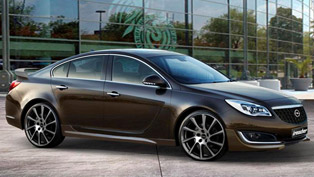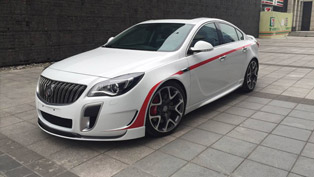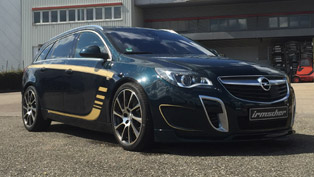Opel Insignia: Design of Opel's Future
The design of the Insignia takes Opel to a new level, showcasing the brand's new confidence with a bold, dynamic and sophisticated car. Understanding the concepts and cues that went into the creation of Insignia is vital to appreciating the driving experience.
The Insignia's look signals a new direction for the brand and shows the new design elements that will be seen in future models. It also highlights the benefits of GM Europe's expanded design center, which opened two years ago and offers the latest technologies in design and engineering.
GM Europe designers spent years, painstakingly refining the surfaces, carving the crisp intersecting lines and colors; testing the textures, feeling the materials and ensuring all the surface finishes were of the highest quality. The result: Sculptural artistry meets German precision.
"With the Insignia, we have redefined our design vocabulary," says Mark Adams, Vice President of Design for GM Europe. "The Insignia is athletic and powerful, yet very elegant. It has movement; surfaces flow harmoniously, with crisp intersecting lines that define the dynamic form, so that you never tire of looking at it. Our aim was to develop a confident look which reinforced the car's superb driving dynamics but also one that made it clear that this was a beautiful vehicle with premium appeal."
Insignia: Flowing graceful lines inside and out
"This is a paradigm shift for Opel," says John Puskar, Director Interior Design at GM Europe. "We wanted to create interior environments for all our future vehicles that are warm, inviting and sporty. The Insignia is the first evidence of this new philosophy."
The overall goal for the design team was to create a simply beautiful car that would herald the next generation for Opel. The exterior's hallmark is its flowing graceful silhouette. The body's sculpted shape is accented by sweeping front and rear light designs and enhanced by a bold radiator grille. A distinctive "blade" feature runs through the body side from behind the front wheel, further emphasizing its taut and rakish lines.
"There are elements of crispness and structure that give the Insignia the feeling of German precision. The sculpted surfaces were then added to this framework to give it movement and make it look fluid and flowing," says Malcolm Ward, exterior Chief Designer.
Interior design in sync with exterior cues
The same design cues are expressed inside the car as well. On opening the doors, the first impression is of the bold wrap around interior. This is dominated by the signature "wing" theme that flows from the front of the instrument panel and dives into the door panels in a downward dynamic curve. The bold surfaces from the exteriors "blade" feature are echoed in the shape of the interior door grab handle, where the bright accent material sweeps dramatically into the door armrest. This sweeping accent is repeated in chrome shapes on the steering wheel and at the front of the center console. All of the materials work together, to create a harmonious, classy feel to the interior. The overall interior has taken a light, spacious approach that is both sporty and welcoming.
The car's lighting both inside and out, is giving Opel a more unique night time appearance. Outside, a distinctive illuminated "wing" design on the front and rear light clusters gives the Insignia a unique signature. Inside, designers have added a warm orangish-red ambient light to enhance the overall atmosphere for night driving. Instrument cluster is illuminated white, but on depressing the "Sport" button, this lighting turns red to match the surrounding illumination.
"Flowing graceful lines give such a strong sense of movement to the interior," Puskar says.
Puskar organizes his interior design group into four specific teams, each focusing on one area of expertise; Interior design, component design, color and trim and design appearance quality. Each of these teams work closely with one another, ensuring that all the elements come together to form a perfectly resolved interior.
On the Insignia, all of the colors and materials have been developed to enhance the premium feel of the interior environment. The sport model uses a high gloss black piano lacquer, to strongly contrast the overall soft feel black grained environment. At the other end of the spectrum, there is a warm environment which enters new territory with a polished Kiba Wood trim, complementing warm brown and light neutral upholstery.
"We've made a radical change in the look, feel and approach to the Insignia's colors and trims," says Peter Jaksch, chief designer of Colors and Trim for GM Europe.
Many themes started in this Interior provide the DNA for future Opel designs. Variations on sculptural artistry – the wing, flowing sculptural forms and a sporty dynamic environment -- will be used moving forward, as Opel refines and builds the vocabulary of its new design language. At the same time, Opel's roots will be expressed with the execution of German precision in all its vehicles. Still, the cars will not be clones of each other. Each car will have its own distinctive personality. Opel aims to be consistent with its design execution but not prescriptive or predictable.
European design center to sculpt future mid-sized cars
GM Europe's Design Center, one of 11 in the company's network, houses GM Europe's exterior, interior and advance design teams, all of which are able to connect with the company's top engineers to maximize synergies. With GM Europe's Engineering and Opel's plant only a few steps away, designers and engineers also keep in close contact with manufacturing to ensure quality is maintained throughout the whole vehicle development.
The European design center provides designers with the location, atmosphere and tools they need to maximize the creative process and create exciting designs for the future. Nearly 350 people work in the growing design function in Rüsselsheim, creating the new products from Saab, Opel, Vauxhall and some future Saturns.
The Insignia is the first car within GM to be developed globally, where the creative process that linked interior and exterior designers from Rüsselsheim to the rest of the world. "The focus was very much on designing a beautiful Opel/Vauxhall that would head the portfolio" Adams said. Technically, the car had to be created to allow for regional tastes and safety requirements.
The new facility utilizes the highest technology, with a state of the art virtual reality center, with its massive screens that allows designers to "build" and test designs and examine them in various environments. Computer programs allow designers to explore a not-yet built interior and exterior with a 360° view from any level and any perspective.
